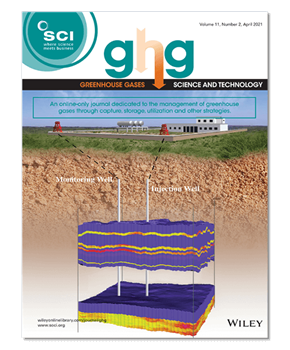Atmospheric removal of methane by enhancing the natural hydroxyl radical sink
Yuyin Wang, Tingzhen Ming, Wei Li, Qingchun Yuan, Renaud de Richter, Philip Davies, Sylvain Caillol
To read and cite the full paper, please visit:
doi.org/10.1002/ghg.2191
First published: 07 November 2022
WHAT'S IT ABOUT?
Methane (CH4) is a potent greenhouse gas with emissions projected to grow over the coming years. Technologies to facilitate its atmospheric removal are therefore in the spotlight as potential tools to combat global warming.
This review paper summarises and proposes methods for the removal of CH4 based on enhancing its principal natural sink in the atmosphere - hydroxyl radicals (°OH). These effectively ‘mop-up’ atmospheric CH4, along with multiple other greenhouse and ozone-depleting gases. °OH forms in the atmosphere via the striking of ozone molecules by UV light from the sun, in the presence of water vapour.
The paper explores how climate change and human activities can contribute to increased atmospheric °OH, either via increased humidity (more water vapour) or increased UV exposure. For example, the expansion of irrigated land to feed a growing population will raise humidity.
Technologies with the potential to further enhance °OH concentrations are set out. The downdraft energy tower, developed in Israel, can use seawater to increase humidity in hot, dry regions, whilst airships could be harnessed to carry artificial sources of UV light.
The paper concludes that if life cycle assessments and atmospheric chemistry modelling of the technologies proposed prove them viable, these strategies may help to win time in the fight against climate change.
From the editors of Greenhouse Gases: Science & Technology
Prof M. Mercedes Maroto-Valer
Director, UK Industrial Decarbonisation Research and Innovation Centre (IDRIC)
Deputy Principal (Global Sustainability) and Director, Research Centre for Carbon Solutions (RCCS)
Heriot-Watt University, UK
Dr Curtis M Oldenburg
Geologic Carbon Sequestration Program Lead, Senior Scientist
Lawrence Berkeley National Laboratory, US
Greenhouse Gases: Science and Technology (GHG:S&T) is dedicated to the management of greenhouse gases through publication of original articles, critical reviews, commentary articles, and short communications of broad interest.
The journal focuses on methods for carbon capture and storage, including negative emissions technologies, as well as utilisation of carbon dioxide as a feedstock for fuels and chemicals. GHG:S&T also addresses mitigation of other greenhouse gases, such as methane (CH4).
This paper by Wang et al shines light on this last topic. Wang et al report on approaches that can be used to increase the concentration of hydroxyl radicals in the atmosphere. This is important because hydroxyl radicals serve to break down CH4 (a potent greenhouse gas), thereby reducing its role in global warming.
This work is also relevant to the hydrogen (H2) economy because H2 inadvertently leaked into the atmosphere also reacts with hydroxyl radicals, reducing their abundance to react with CH4. The interconnectedness of our natural environment remains both an enormous challenge and opportunity in the need to solve the energy-climate crisis.
ABSTRACT
According to the latest report from the intergovernmental panel on climate change (IPCC), currently, global warming due to methane (CH4) alone is about 0.5°C while due to carbon dioxide (CO2) alone is about 0.75°C. As CH4 emissions will continue growing, in order to limit warming to 1.5˚C, some of the most effective strategies are rapidly reducing CH4 emissions and developing large scale CH4 removal methods. The aim of this review article is to summarise and propose possible methods for atmospheric CH4 removal, based on the hydroxyl radical (°OH), which is the principal natural sink of many gases in the atmosphere and on many water surfaces. Inspired by mechanisms of °OH generation in the atmosphere and observed or predicted enhancement of °OH by climate change and human activities, we proposed several methods to enhance the °OH sink by some physical means using water vapour and artificial UV radiation.
MEET THE RESEARCHER
Dr Wei Li
Institute for Materials and Processes, School of Engineering, University of Edinburgh, Scotland, UK
Why is it important to focus on mitigating the impacts of atmospheric methane?
According to the latest report from the intergovernmental panel on climate change (IPCC), currently, global warming due to methane (CH4) alone is about 0.5°C while due to carbon dioxide (CO2) alone is about 0.75°C. Because CH4 emissions will continue growing and CH4 is so powerful and persists in the atmosphere for such a short period – years, compared with centuries for CO2 – cutting emissions or destroying the gas in the air offers one of the few mechanisms we may have to meaningfully reduce near-term warming.
To what extent do the technologies discussed have the potential to limit global warming and can they act as a solution to meeting the targets of the Paris Agreement?
First, to meet the targets of the Paris Agreement, we need a portfolio of technologies. It is difficult to find a single “silver bullet”. Second, any technology tackling global warming needs to have an impact at a climate relevant scale. That's why we need to think big and bold. The technologies discussed in this article have the potential of gigaton scale of CO2 equivalent removal and thus would have impact at climate-relevant scale.
If we shift towards a hydrogen-based economy, H2 emissions will increase. Given that H2 can ‘mop-up’ hydroxyl radicals and reduce their atmospheric concentration, what implications does this pose on the research discussed in this review?
This will only make the argument of hydroxyl radical enhancement stronger; we will need more hydroxyl radicals to balance the budget. This will imply that we need to act with more urgency to advance the technologies reviewed in this article. Collaborations with atmospheric chemistry experts will be essential to understand the more explicit implications.
Where does research need to focus now if there is to be real-world application of the techniques discussed in this review paper to enhance the hydroxyl radical sink for methane?
Change of humidity and introduction of artificial UV radiation are the two main topics here, which we believe deserve more attention from the scientific community to help evaluate their potential risks, impacts, costs and public acceptability. Also, those strategies may be expensive and have externalities, so careful assessments (e.g., techno-economic analysis, life cycle assessment) will be required to compare the proposed schemes versus CH4 emission mitigation approaches. We believe that one of the main knowledge gaps for such assessments is the great diversity among different atmospheric chemistry models which predict °OH variability, distribution, and trends.




